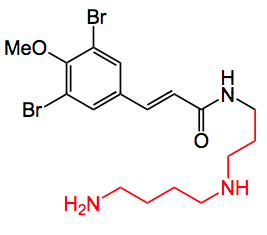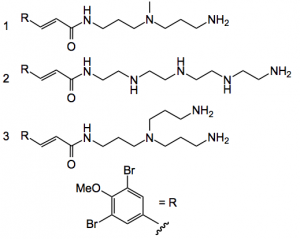The Brunel group from the CNRS in Marseille has recently discussed the medicinal chemistry of the lanthelliformisamines, for example lanthelliformisamine B:
 These compounds are antibiotic enhancers and do not really possess antibacterial activity on their own. The compounds are proposed to increase the internal antibiotic concentration in resistant bacteria. This is achieved by bypassing the enzymatic and mechanistic effects that are responsible for the reduction of active antibacterial drugs within the cell. The med. chem. program was simple enough, vary the polyaminoalkyl side chain (in red above). Starting with chains , for example, 1,2-ethylenediamine 1,3-propanediamine, moving up to a cadaverine chain. Then incorporating rings such as morpholine, branched chains, the usual medicinal chemistry things.
These compounds are antibiotic enhancers and do not really possess antibacterial activity on their own. The compounds are proposed to increase the internal antibiotic concentration in resistant bacteria. This is achieved by bypassing the enzymatic and mechanistic effects that are responsible for the reduction of active antibacterial drugs within the cell. The med. chem. program was simple enough, vary the polyaminoalkyl side chain (in red above). Starting with chains , for example, 1,2-ethylenediamine 1,3-propanediamine, moving up to a cadaverine chain. Then incorporating rings such as morpholine, branched chains, the usual medicinal chemistry things.
The compounds were all inactive except for one of the natural products against various bacterial strains. Now adding these compounds to doxycycline restored the activity of the antibiotic against 3 strains of Gram-negative bacteria. The natural compounds were also active in this assay and three of the synthetic analogues with the following amino side chains with values between 3 and 12 μM:
This synergy was investigated further as it was known from the literature than lipophillic groups and polyamines are important for permeabilisation. This was checked by measuring the release of bacterial ATP but no ATP was observed. To summarise in the Author’s words: “Among the synthesised derivatives, some compounds dramatically affected the antibiotic susceptibility of E. aerogenes, P. aeruginosa, and K. pneumoniae MDR strains. This efficiency was correlated with the inhibition of a dye transport, suggesting that these molecules can act on the activity of drug transporters. Further studies are now underway. “
So here is a nice approach to the problem of antibiotic resistance. I hope to read more about it in the future.
6,972 total views, 1 views today
